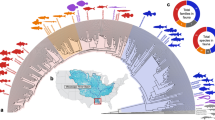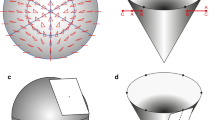Abstract
Largely due to L. F. Bookstein, geometric morphometrics has been developed as an amalgamation of techniques drawn from mathematical statistics, non-Euclidean geometry and computer graphics, applied to labelled points (landmarks) and the biological images upon which they are registered. A tool of fundamental importance is the method of interpolation known as the thin-plate spline. Bookstein's sample-oriented procedure of relative warps, applied to data composed of coordinate pairs observed on eight landmarks on three samples of two species of fossil marine ostracods (bivalved microcrustacean),Notocarinovalva airella andN. yulecartensis, separated in time, is used to obtain weight matrices, which, when appropriately partitioned, constitute the familiar data matrices of multivariate statistical analysis. Standard multivariate statistical analysis of samples may be carried out in the tangent space to shape space at the Procrustes average shape. Linear discriminant function scores were used for assessing, approximately, the evolutionary relevance of shape change and change in size (based on standard distance measures) in the species from the upper and lower Oligocene and lower middle Miocene of Victoria, Australia. The findings indicate that a small, though consistent, change in non-uniform shape of the carapace has taken place. The analysis indicates that the evolution in shape of the carapace could have been caused by random genetic drift in moderately large populations, tempered by weak selection.
Similar content being viewed by others
References
Berthelon, L. 1994. Les hétérochronies du développement chez les ostracodes. Thèse pour le diplôme de Doctorat à l'Université Montpellier II, Octobre 1994.
Blackith, R. E. and R. A. Reyment. 1971.Multivariate Morphometrics. Academic Press: London.
Bookstein, F. L. 1987. Random walk and the existence of evolutionary rates.Paleobiology 13, 446–464.
Bookstein, F. L. 1989. Principal warps: the thin-plate spline and the decomposition of deformations.IEEE Trans. Pattern Anal. Machine Intelligence 11, 567–585.
Bookstein, F. L. 1991.Morphometric Tools for Landmark Data: Geometry and Biology. New York: Cambridge University Press.
Bookstein, F. L. 1995. The morphometric synthesis for landmarks and edge-elements in images.Terra Nova 7, 393–407.
Bookstein, F. L. 1996. Combining the tools of geometric morphometrics. InProceedings of NATO Advanced Study Institute on Morphometrics (Il Ciocco, Italy, 1993), L. F. Marcuset al. (Eds).
Bookstein, F. L. and R. A. Reyment. 1989. Microevolution in MioceneBrizalina (Foraminifera) studied by canonical variate analysis and the analysis of landmarks.Bull. Math. Biol. 51, 657–679.
Bulmer, M. G. 1980.The Mathematical Theory of Quantitative Genetics. London: Oxford University Press.
Burnaby, T. P. 1966. Growth invariant discriminant functions and generalized distances.Biometrics 22, 96–110.
Cheetham, A. H., J. B. C. Jackson and L. C. Hayek. 1993. Quantitative genetics of bryozoan phenotypic evolution. 1. Rate tests for random change versus selection in differentiation of living species.Evolution 47, 1526–1538.
Cheverud, J. M. 1988. A comparison of genetic and phenotypic correlations.Evolution 42, 958–968.
Ducasse, O. and L. Rousselle. 1979.Les Hammatocythere (ostracodes) de l'Oligocène aquitain.Bull. Inst. Géol. Bassin Aquitaine 25, 221–255.
Duchon, J. 1976. Interpolation des fonctions de deux variables suivant la principe de la flexion des plaques minces.RAIRO Model. Math. Anal. Numér. 10, 5–12.
Falconer, D. S. 1981.Introduction to Quantitative Genetics, 2nd rev. ed. New York: Longmans.
Gower, J. C. 1971. Statistical methods of comparing different multivariate analyses of the same data, InMathematics in the Archaeological and Historical Sciences, F. R. Hodson, D. G. Kendall and P. Tautu (Eds), pp. 138–149. Edinburgh: Edinburgh University Press.
Haldane, J. B. S. 1949. Suggestions as to the quantitative measurement of rates of evolution.Evolution 3, 51–56.
Hartl, D. L. 1980.Principles of Population Genetics. Sunderland, MA: Sinauer.
Havel, J. E., O. D. N. Hebert and L. D. Delorme. 1990. Genetics of sexual Ostracoda from a low Arctic site.J. Evol. Biol. 3, 65–84.
Hegmann, W. J. P. and J. C. De Vries. 1970. Are genetic and environmental correlations correlated?Nature 220 284–285.
Jolicoeur, P. 1963. The degree of generality of robustness inMartes americana.Growth 27, 1–27.
Klein, F. 1925.Elementarmathematik vom höheren Standpunkt aus, Vol. II. Berlin: Verlag Julius Springer.
Lande, R. 1976. Natural selection and random genetic drift in phenotypic evolution.Evolution 30, 314–334.
Lande, R. 1979. Quantitative genetic analysis of multivariate evolution, applied to brain: body size allometry.Evolution 33, 402–416.
Lande, R. 1980. The genetic covariance between characters maintained by pleiotropic evolution.Genetics 94, 203–215.
Manly, B. F. J. 1985.The Statistics of Natural Selection. London: Chapman and Hall.
McKenzie, K. G., R. A. Reyment and E. R. Reyment. 1991. Eocene-Oligocene Ostracoda from South Australia and Victoria, Australia.Revista Española de Paleontología 6, 135–175.
Mourant, A. E., A. C. Kopec and K. Domaniewska-Sobczak. 1976.The Distribution of Human Blood Groups and Other Polymorphisms. London: Oxford University Press.
Neil, J. V. 1994. Miocene Ostracoda of the Trachyleberididae and Hemicytheridae from the Muddy Creek area, south-western Victoria.Mem. Museum Victoria 54, 1–49.
Penrose, L. S. 1954. Distance, size and shape.Annals of Eugenics 18, 337–343.
Rao, C. R. 1952.Advanced Statistical Methods in Biometric Research. New York: Wiley.
Rao, C. R. 1966. Discriminant functions between composite hypotheses and related problems.Biometrika 53, 339–345.
Reyment, R. A. 1980.Morphometrical Methods in Biostratigraphy. London: Academic Press.
Reyment, R. A. 1982a. Phenotypic evolution in a Cretaceous foraminifer.Evolution 36, 1182–1199.
Reyment, R. A. 1982b. Analysis of transspecific evolution in Cretaceous ostracods.Paleobiology 8, 293–306.
Reyment, R. A. 1983. Phenotypic evolution in microfossils.Evolutionary Biology 16, 209–254.
Reyment, R. A. 1991.Multidimensional Palaeobiology. London: Pergamon Press. (Includes an Appendix by L. F. Marcus.)
Reyment, R. A. and K. G. Jöreskog. 1993.Applied Factor Analysis in the Natural Sciences. New York: Cambridge University Press. (Includes an Appendix by L. F. Marcus.)
Reyment, R. A., R. E. Blackith and N. A. Campbell. 1984.Multivariate Morphometrics, 2nd ed. London: Academic Press.
Rohlf, F. J. 1993. Relative warp analysis and an example of its application to mosquito wings. InContributions to Morphometrics, L. F. Marcus, E. Bello and A. García Valdecasas (Eds), pp. 131–159. Monografias, Museo Nacional de Ciencias Naturales, Madrid.
Rohlf, F. J. and D. Slice. 1990. Extensions of the Procrustes method for the optimal superimposition of landmarks.Systematic Zoology 39, 40–59.
Teissier, G. 1938. Un essai d'analyse factorielle. Les variants sexuels deMaia squinada.Biotypologie 7, 73–96.
Theisen, B. F. 1966. The life history of seven species of ostracods from Danish brackish water localities.Medd. fra Danmarks Fiskeri og Havsunders (Copenhagen) N.S. 4, 215–270.
Thompson, D. W. 1917.On Growth and Form. New York: Cambridge University Press.
Wright, S. 1931. Evolution in Mendelian populations.Genetics 16, 97–159.
Wright, S. 1932. General, group and special size factors.Genetics 17, 603–619.
Wright, S. 1968.Evolution and Genetics of Populations. I. Genetic and Biometric Foundations. Chicago: University of Chicago Press.
Author information
Authors and Affiliations
Rights and permissions
About this article
Cite this article
Reyment, R.A. Evolution of shape in oligocene and mioceneNotocarinovalva (Ostracoda, Crustacea): A multivariate statistical study. Bltn Mathcal Biology 59, 63–87 (1997). https://doi.org/10.1007/BF02459471
Received:
Accepted:
Issue Date:
DOI: https://doi.org/10.1007/BF02459471




